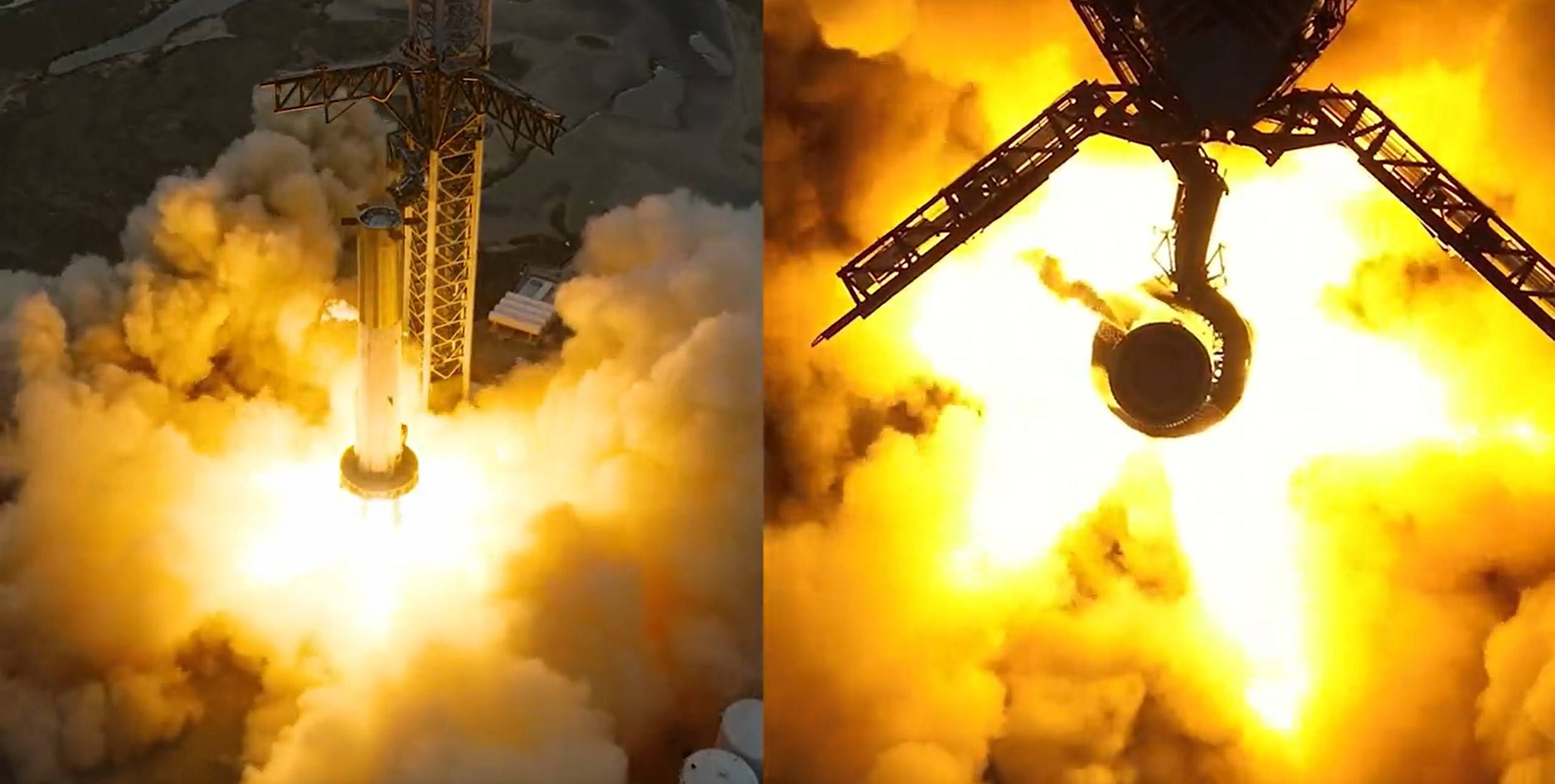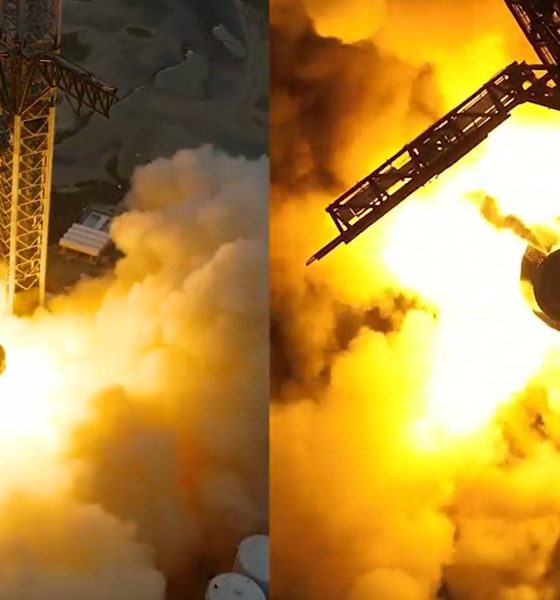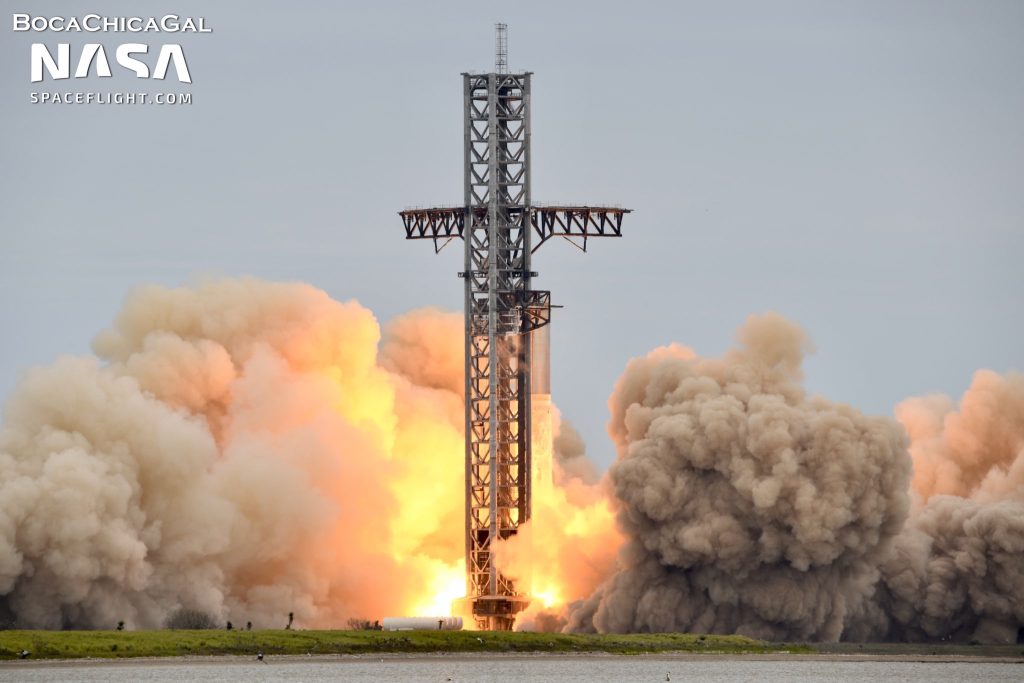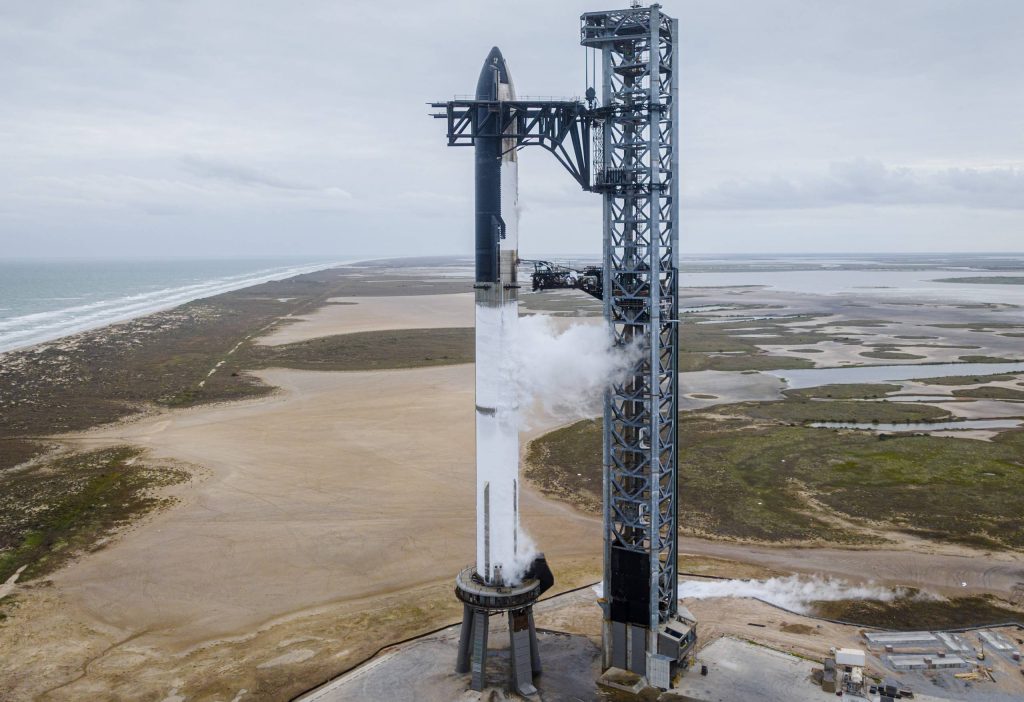

News
SpaceX Starship booster survives record-breaking 31-engine static fire
SpaceX’s Starship rocket has survived a record-breaking engine test – potentially the most powerful static fire in the history of rocketry.
According to CEO Elon Musk, Super Heavy Booster 7 (B7) ultimately ignited 31 of its 33 Raptor engines. One engine was manually disabled “just before” the static fire, while the other faulty engine automatically shut down while attempting to ignite. The other 31 Raptors, however, completed a “full duration” static fire that lasted about five seconds. Musk says that even with two engines disabled, those that remained were “still enough…to reach orbit” – an excellent result despite the static fire’s imperfections.
Most importantly, Super Heavy Booster 7 survived the test without catching fire, exploding, or popping its tanks. To partially counteract the thrust of its Raptor engines, the rocket’s tanks were filled with some 3000 tons (6.6M lbs) of liquid oxygen and methane propellant. The stool-like orbital launch mount (OLM), which also survived the test in one piece, held Starship down with 20 clamps to counteract any remaining thrust. From SpaceX’s perspective, the fact alone that its only orbital-class Starship launch site survived the ordeal is likely enough for it to consider the static fire a success. But the test was much more than that.
The update that's rolling out to the fleet makes full use of the front and rear steering travel to minimize turning circle. In this case a reduction of 1.6 feet just over the air— Wes (@wmorrill3) April 16, 2024
Incinerating rocket records
Despite losing two Raptors, SpaceX still broke the all-time record for the number of rocket engines ignited simultaneously. That record was held by the Soviet N1 rocket, which launched four times with 30 NK-15 engines in the late 1960s and early 1970s. None of its test flights were successful, but N1 still set the record for the most thrust produced by a single rocket, generating up to 4500 tons (9.9M lbf) of thrust at liftoff.
Neither SpaceX nor CEO Elon Musk has confirmed it, reducing the odds that Super Heavy Booster 7 broke that historic thrust record. But it certainly could have. Each Raptor 2 engine can generate up to 230 tons (507,000 lbf) of thrust at sea level. Raptor is theoretically designed to throttle as low as 40%, or 92 tons (~200,000 lbf) of thrust. With 33 engines operating nominally at their minimum throttle setting, Super Heavy would have produced 3036 tons (~6.7M lbf) of thrust during today’s static fire – not a record.
For 31 Raptors to break N1’s thrust record, the average throttle setting would have had to be around 64% or higher – far from unreasonable. From a data-gathering perspective, a full-thrust static fire would be the most valuable 33-engine test SpaceX could attempt, but it would also be the riskiest and most stressful for the rocket and pad.
Former SpaceX executive Tom Mueller says that SpaceX broke N1’s record. Mueller is effectively the father of the Raptor engine, and likely still gets information straight from SpaceX engineers he used to work with. Still, one would expect SpaceX itself to proudly confirm as much if a rocket it built became the most powerful in history.
The most powerful rocket test in history?
Whether or not Starship became the most powerful rocket in history, it has likely become the most powerful rocket ever tested on the ground. The first stage of Saturn V produced around 3400 tons (7.5M lbf) of thrust during its first sea-level static fire in 1965. Likely contributing to its failure, N1’s booster was never static-fired. Other powerful rockets like the Space Shuttle and SLS use or used a combination of solid rocket boosters and liquid engines that cannot be tested together on the ground.
Unless SpaceX’s goal was a minimum-throttle static fire, Starship’s 31-Raptor static fire likely beat Saturn V’s record to become the most powerful ground test in the history of rocketry.
SpaceX’s next steps
While the 31 that did ignite appeared to perform about as well as SpaceX could have hoped, the two engines missing from February 9th’s historic Starship static fire have probably complicated the company’s next steps. To be fully confident in Starship’s ability to launch and fly a safe distance away from the launch site, SpaceX would likely need to complete a full 33-engine test. Meanwhile, Starship can’t fly until the Federal Aviation Administration approves a launch license, and the FAA could be stodgy enough to deny SpaceX a license without a perfect 33-engine static fire.
Alternatively, the FAA may accept that Starship could still safely launch and reach orbit while missing several Raptors. SpaceX could also guarantee that it will only allow Starship to lift off if all 33 engines are active, in which case a second 33-engine static fire attempt may not be necessary.


If SpaceX is happy with Booster 7’s 31-engine test results and isn’t too put off by any pad damage the test may or may not have caused, it will likely focus on finishing Starship 24. Ship 24 will then be transported back to the pad and reinstalled on top of Booster 7. SpaceX may choose to conduct another wet dress rehearsal or a static fire with the fully-stacked Starship, but it may also deem additional testing unnecessary.
Once all those tasks are completed, Ship 24 and Booster 7 will be ready to support Starship’s first orbital launch attempt. Prior to February 9th’s static fire, SpaceX CEO Elon Musk and COO/President Gwynne Shotwell agreed that Starship’s orbital launch debut could happen as early as March 2023. After today’s test, a March 2023 launch may be within reach.
Rewatch Super Heavy Booster 7’s historic static fire below.

News
Tesla is not sparing any expense in ensuring the Cybercab is safe
Images shared by the longtime watcher showed 16 Cybercab prototypes parked near Giga Texas’ dedicated crash test facility.

The Tesla Cybercab could very well be the safest taxi on the road when it is released and deployed for public use. This was, at least, hinted at by the intensive safety tests that Tesla seems to be putting the autonomous two-seater through at its Giga Texas crash test facility.
Intensive crash tests
As per recent images from longtime Giga Texas watcher and drone operator Joe Tegtmeyer, Tesla seems to be very busy crash testing Cybercab units. Images shared by the longtime watcher showed 16 Cybercab prototypes parked near Giga Texas’ dedicated crash test facility just before the holidays.
Tegtmeyer’s aerial photos showed the prototypes clustered outside the factory’s testing building. Some uncovered Cybercabs showed notable damage and one even had its airbags engaged. With Cybercab production expected to start in about 130 days, it appears that Tesla is very busy ensuring that its autonomous two-seater ends up becoming the safest taxi on public roads.
Prioritizing safety
With no human driver controls, the Cybercab demands exceptional active and passive safety systems to protect occupants in any scenario. Considering Tesla’s reputation, it is then understandable that the company seems to be sparing no expense in ensuring that the Cybercab is as safe as possible.
Tesla’s focus on safety was recently highlighted when the Cybertruck achieved a Top Safety Pick+ rating from the Insurance Institute for Highway Safety (IIHS). This was a notable victory for the Cybertruck as critics have long claimed that the vehicle will be one of, if not the, most unsafe truck on the road due to its appearance. The vehicle’s Top Safety Pick+ rating, if any, simply proved that Tesla never neglects to make its cars as safe as possible, and that definitely includes the Cybercab.
Elon Musk
Tesla’s Elon Musk gives timeframe for FSD’s release in UAE
Provided that Musk’s timeframe proves accurate, FSD would be able to start saturating the Middle East, starting with the UAE, next year.

Tesla CEO Elon Musk stated on Monday that Full Self-Driving (Supervised) could launch in the United Arab Emirates (UAE) as soon as January 2026.
Provided that Musk’s timeframe proves accurate, FSD would be able to start saturating the Middle East, starting with the UAE, next year.
Musk’s estimate
In a post on X, UAE-based political analyst Ahmed Sharif Al Amiri asked Musk when FSD would arrive in the country, quoting an earlier post where the CEO encouraged users to try out FSD for themselves. Musk responded directly to the analyst’s inquiry.
“Hopefully, next month,” Musk wrote. The exchange attracted a lot of attention, with numerous X users sharing their excitement at the idea of FSD being brought to a new country. FSD (Supervised), after all, would likely allow hands-off highway driving, urban navigation, and parking under driver oversight in traffic-heavy cities such as Dubai and Abu Dhabi.
Musk’s comments about FSD’s arrival in the UAE were posted following his visit to the Middle Eastern country. Over the weekend, images were shared online of Musk meeting with UAE Defense Minister, Deputy Prime Minister, and Dubai Crown Prince HH Sheikh Hamdan bin Mohammed. Musk also posted a supportive message about the country, posting “UAE rocks!” on X.
FSD recognition
FSD has been getting quite a lot of support from foreign media outlets. FSD (Supervised) earned high marks from Germany’s largest car magazine, Auto Bild, during a test in Berlin’s challenging urban environment. The demonstration highlighted the system’s ability to handle dense traffic, construction sites, pedestrian crossings, and narrow streets with smooth, confident decision-making.
Journalist Robin Hornig was particularly struck by FSD’s superior perception and tireless attention, stating: “Tesla FSD Supervised sees more than I do. It doesn’t get distracted and never gets tired. I like to think I’m a good driver, but I can’t match this system’s all-around vision. It’s at its best when both work together: my experience and the Tesla’s constant attention.” Only one intervention was needed when the system misread a route, showcasing its maturity while relying on vision-only sensors and over-the-air learning.
News
Tesla quietly flexes FSD’s reliability amid Waymo blackout in San Francisco
“Tesla Robotaxis were unaffected by the SF power outage,” Musk wrote in his post.

Tesla highlighted its Full Self-Driving (Supervised) system’s robustness this week by sharing dashcam footage of a vehicle in FSD navigating pitch-black San Francisco streets during the city’s widespread power outage.
While Waymo’s robotaxis stalled and caused traffic jams, Tesla’s vision-only approach kept operating seamlessly without remote intervention. Elon Musk amplified the clip, highlighting the contrast between the two systems.
Tesla FSD handles total darkness
The @Tesla_AI account posted a video from a Model Y operating on FSD during San Francisco’s blackout. As could be seen in the video, streetlights, traffic signals, and surrounding illumination were completely out, but the vehicle drove confidently and cautiously, just like a proficient human driver.
Musk reposted the clip, adding context to reports of Waymo vehicles struggling in the same conditions. “Tesla Robotaxis were unaffected by the SF power outage,” Musk wrote in his post.
Musk and the Tesla AI team’s posts highlight the idea that FSD operates a lot like any experienced human driver. Since the system does not rely on a variety of sensors and a complicated symphony of factors, vehicles could technically navigate challenging circumstances as they emerge. This definitely seemed to be the case in San Francisco.
Waymo’s blackout struggles
Waymo faced scrutiny after multiple self-driving Jaguar I-PACE taxis stopped functioning during the blackout, blocking lanes, causing traffic jams, and requiring manual retrieval. Videos shared during the power outage showed fleets of Waymo vehicles just stopping in the middle of the road, seemingly confused about what to do when the lights go out.
In a comment, Waymo stated that its vehicles treat nonfunctional signals as four-way stops, but “the sheer scale of the outage led to instances where vehicles remained stationary longer than usual to confirm the state of the affected intersections. This contributed to traffic friction during the height of the congestion.”
A company spokesperson also shared some thoughts about the incidents. “Yesterday’s power outage was a widespread event that caused gridlock across San Francisco, with non-functioning traffic signals and transit disruptions. While the failure of the utility infrastructure was significant, we are committed to ensuring our technology adjusts to traffic flow during such events,” the Waymo spokesperson stated, adding that it is “focused on rapidly integrating the lessons learned from this event, and are committed to earning and maintaining the trust of the communities we serve every day.”








